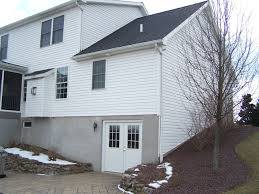How Does Loan Type on a Mortgage Impact Flood Insurance Options?
July 25th, 2019
4 min read
By Chris Greene

In this episode of The Flood Guru podcast we are discussing how mortgage loan types can impact flood insurance options. We are going to discuss 4 main mortgage loan types, some of the restrictions, and what the flood insurance options?
Before we can understand the flood insurance impact we must understand the loan types. So lets discuss FHA, VA, USDA, and Conventional loans.

FHA Loans
These are called Federal Housing Administration loans. This type of loan is very popular with first time home buyers.. This type of loan has three requirements income, down payment, and debt to income ratios.
Income restrictions
-The income restrictions on these loans is not actually the amount of money you earn but instead at least two open credit accounts
-No delinquent federal debt or judgements
-Account for cash gifts that help with down payment.
Down Payment
With the FHA, the minimum down payment depends on your credit score. With a credit score of 580 or higher, the minimum down payment is 3.5%. With a score of 500 to 579, the minimum down payment is 10%

Debt to Income
The debt-to-income ratio, known as DTI, measures the percentage of your pretax income that you spend on monthly debt payments, including mortgage, credit cards, student loans and other obligations.The FHA requires a debt-to-income ratio of 50% or less.
VA Loans
VA loans are a unique loan offered to those who have served our country. Veteran Affairs does not actually do loans but instead allows banks and mortgage companies to do the loan. As a result you have the VA that sets part of the requirements and the bank or mortgage company that sets their portion. So you could get different numbers from every bank but there are some general guidelines to follow on debt to income ratios, down payment, and loan limits.

Debt to Income
if the total debt-to-income ratio is over 41%, lenders will need to provide proof of an applicant’s ability to repay the loan,They do this by assessing your “residual income,” accounting for all your monthly living expenses, as well as what your mortgage payment would be.
Down Payment
While VA loans do not have a down payment requirement making a down payment can low the VA funding fee. So what is the VA funding fee?The amount of the funding fee is based on your service, how much you’re putting down and if you’ve ever had a VA-backed loan before.
Loan limits
The VA loan limit is $484,350 for a single-family house in a typical U.S. county. According to Nerd Wallet this requirement will be changing in 2020
USDA loans
United States of Department of Agriculture Rural Development has a unique loan department that has some guidelines that other loans do not. The guidelines consist of credit score, income, and location of the property.
Credit Score
USDA loans generally have a minimum requirement of a 640 credit score according to the USDA
Income
While the income guidelines are not set like they are on some other loans you still have to show that you have stable and dependable income. Your adjusted household income also can not exceed 115% of median income in the area.
Location of the Property
This is where USDA loans are set apart they are one of the only loan types that are based on location. These areas are generally open country areas that can have populations up to 35,000. Some times after a disaster has destroyed an area USDA loans can help with the redevelopment of that area. One example is after tornados destroyed parts of Tuscaloosa Alabama. USDA extended these requirements to help with the development. The location must also be a primary residence, site must have direct access to the street, road, or driveway. The property must also have working utilities, water, and waste disposal.

Conventional Loans
A conventional is a loan that is not backed by a government agency like FHA, USDA, and VA. They have restrictions like credit score, occupancy, income, and assets. Their downpayment requirements generally are about 10-20%.
Conventional Loan Credit Scores
The general credit score guidelines are 620-640 on these loan types
Conventional Loan Occupancy
Conventional loans can be used to finance a primary residence, a second home, vacation property or a rental property. This gives this type of loan a lot more flexibility.
Conventional Loan Income
. Debt to income can not exceed 43% and income is verified through pay check stubs, tax returns, and w-2's.
Conventional Loan Assets
Bank and investment statements will be verified to ensure the borrower has sufficient assets to close. These funds must be able to cover a down payment plus associated closing costs.
Loan Type Flood Insurance Obstacles and Availability
Historically FEMA has been the only flood insurance option on all loan types. However the development of private market flood insurance over the last 10 years has allowed other options to be available on non government loans like conventional loans. Being forced to purchase flood insurance through FEMA has caused many of these government loans to fall apart. The reason is flood insurance premiums have to be counted in the house payment. Its not usual for this to increase a house payment by 100-200 dollars a month. It has also made reselling a home a challenge if a buyer is doing a government loan.
What's changing on Government Loans
Starting July 1, 2019 the FDIC has passed a bill that will allow private flood insurance on all loan types. This could remove alot of these hurdles on housing payments from flood insurance to go away. This law change will now allow private flood insurance on FHA, VA, and USDA loans.
Flood Insurance Options
So we have discussed the different loan types, some of their restrictions, and flood insurance availability. So what are the two options for flood insurance. Well there is FEMA or NFIP and private flood insurance. While there are benefits to each one lets discuss them
FEMA or NFIP Private Flood
Building max on residential $250k . No building max of $250k
Contents maxed at $100k Contents not limited to $100k
$250 surcharge for non primary No surcharge for non primary
Backed by the government Backed by private companies
Must accept everyone Properties can be denied
As you can see there are a lot of differences between FEMA and private flood insurance so it's important to understand exactly what your options are and the best fit for you. Want to learn more about the options? Visit our website Flood Insurance Guru, our YouTube channel or Facebook page The Flood Insurance Guru where we do daily flood education videos. You can also click the link below to learn more.

